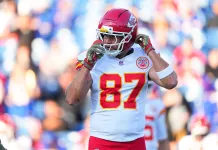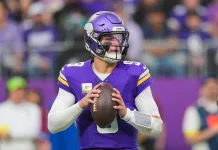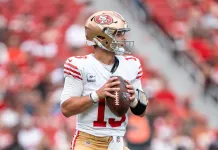This guest article from Ryan Heath of Fantasy Points appeared in the 2025 VSiN NFL Betting Guide.
The Fantasy Points Data Suite is the most valuable tool available for bettors and fantasy managers alike. To back up that claim, I’ve used it to pull a stat for all 32 NFL teams with major fantasy football or betting implications.
Feel free to read this article as a typical piece you’d use to prepare for your fantasy drafts. But it’s also full of examples of how you can get the most out of the Data Suite. If you’re feeling inspired, sign up today.
Arizona Cardinals
Among 100 qualifying WRs and TEs, Marvin Harrison Jr. saw the 4th-highest share of his targets on the outside (89%) rather than over the middle of the field. Only Jahan Dotson, Amari Cooper, and George Pickens saw a larger percentage of their targets coming outside.
That’s pretty bad, considering that targets over the middle are on average worth about 22% more yards than targets on the outside, especially after TE Trey McBride just vacuumed up the highest first-read target share by a TE in Fantasy Points Data history (33.6%) in that over-the-middle role.
Zooming in further, Corner and Go routes alone made up nearly a third of Harrison’s route tree as a rookie, his frequency of each ranking above the 74th percentile. And these were by far his two worst routes from a separation perspective, ranking below the 30th percentile on each by Average Separation Score.
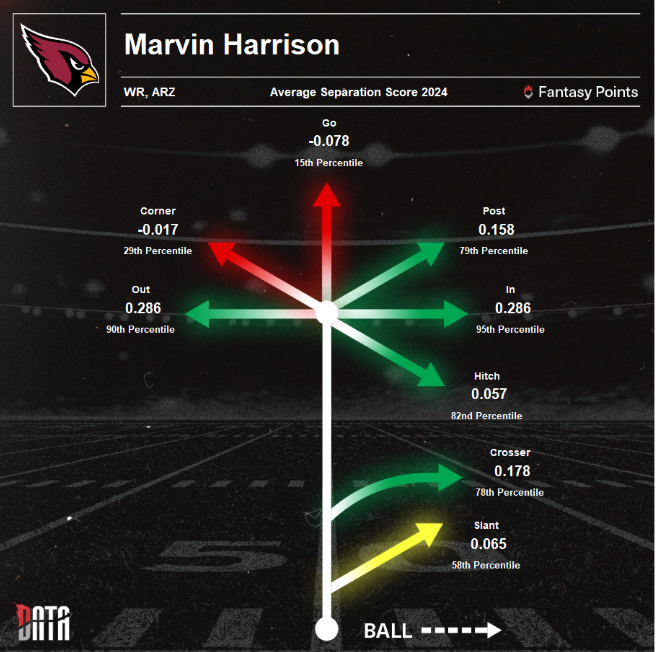
Harrison’s strengths on in-breaking routes and over the middle simply weren’t highlighted during his rookie season. Even after the team favorably adjusted his usage on crossers, his receiving YPG average increased only slightly from 49.4 to 55.9.
The Cardinals haven’t signed any additional receivers with a history of playing this field-stretcher role and have given no indication they intend to change Harrison’s deployment after retaining the same head coach and play caller. I’ll be generally fading Harrison in favor of players like Davante Adams, Tee Higgins, Jaxon Smith-Njigba, or Rashee Rice.
Atlanta Falcons
Across the full 2024 season, Drake London led the NFL in end zone target share, seeing 56% of the Falcons’ end zone targets.
London also commanded six end zone looks across Michael Penix’s three starts. In other words, London averaged 117.3 receiving YPG and 2.0 end zone targets per game with Penix, paces that would have led all WRs over the past four seasons.
Given Penix’s affinity for the deep ball (throwing 20+ yards downfield at the NFL’s 6th-highest rate), the Falcons’ suspect defense, and their only other pass-catcher over six feet tall in Kyle Pitts falling to a career-low 67.4% route participation rate last season, London strikes me as one of the better bets to reach double-digit TDs in 2025.
Recommended Prop: Drake London Over 6.5 receiving TDs
Baltimore Ravens
After a reportedly traumatic August car crash and tightrope surgery the previous November, Mark Andrews ran just a 54.9% route share over the first 9 weeks of 2024, drawing 3.2 targets per game on just an 18% TPRR. All would have represented career lows since his rookie season.

But as Andrews’ health improved from Week 10 on, his route share grew to 66.4%, commanding 5.0 targets per game on a 24% TPRR, numbers much closer to his career rates. He averaged 14.0 FPG over this stretch (~TE4).

Some of Andrews’ late-season production was fueled by touchdown efficiency, and we’ve seen mixed results from players returning from Andrews’ injury. But some other players like Tony Pollard have performed worse immediately following the same injury and procedure, before largely returning to form in the second year removed.
At Andrews’ TE8 ADP (outside the top-100 overall players on platforms like Underdog), there’s little risk in finding out whether he can return to form as Pollard did and reclaim an every-down role. TEs with multiple previous top-6 fantasy seasons typically experience little to no falloff in production at age 30, which Andrews will be at the start of the season.
Buffalo Bills
Rather than seeing increased playing time as many young players do, Dalton Kincaid’s route share fell from 65.1% (~TE18) as a rookie to just 57.7% (~TE25) during his second season. This stemmed from Kincaid’s inability to function as an inline blocker, meaning he mostly gets on the field in the slot or in 2-TE sets.
But Khalil Shakir broke out in 2024, amassing a career-high 100 targets and ranking top-5 in catch rate on “true” chances (catchable and non-designed targets) while running 73.1% of his routes from the slot. With the slot position occupied, this eliminated one of Kincaid’s only two paths to getting on the field.
And the other didn’t prove fruitful either, as the Bills ranked just 17th in 12-personnel usage (21.4%) despite speculation they’d play significantly more 2-TE sets leading up to 2024.
Kincaid occupies an awkward spot in today’s NFL. He’s not big enough to block like a TE, but not shifty enough to outplay his team’s slot receiver. In other words, as TE guru Max Toscano explains here, Kincaid fails the “WR test,” making it very difficult for him to get on the field in 1-TE sets. (Sure enough, Kincaid ran just a 53.3% route share on plays the Bills were in 11-personnel.)
You can safely skip Kincaid as a late-round flyer in your fantasy drafts.
Carolina Panthers
Looking only at throws deemed “on-target”, Bryce Young’s receivers dropped the most air yards in the NFL last season (210).
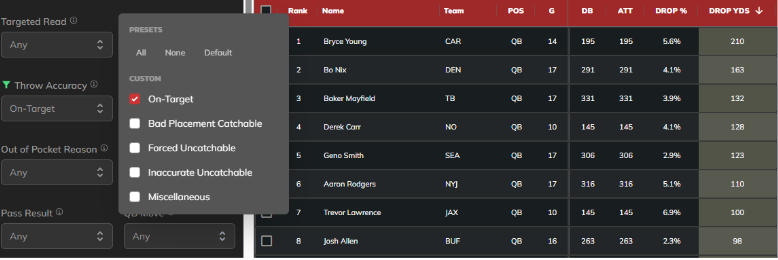
Carolina’s primary outside receivers — Xavier Legette and David Moore — combined for 11 drops while lined up out wide. Coincidentally, that’s the same number of targets Adam Thielen drew from out wide all season (on the occasions the team tried him there out of desperation).
This is all to say that Young had no dependable outside WRs in 2024. Despite the lack of weapons, he ranked top-10 in accuracy and catchable throw rate on throws traveling 20 or more yards downfield, or top-15 in highly accurate throw rate when targeting an outside receiver (50.7%).
So it makes a lot of sense that the Panthers elected to use the No. 8 overall pick on X receiver Tetairoa McMillan. WRs drafted inside the top-10 by the NFL since 2021 have averaged ~7.5 targets per game and ~1,012 receiving yards as rookies, reflecting teams’ intentions to give these players ample opportunity early on.
So long as Young’s growth as a passer in 2024 translates into 2025, McMillan has an excellent shot to exceed 900 receiving yards.
Recommended Prop: Tetairoa McMillan 900+ receiving yards (DraftKings, +200)
Chicago Bears
D.J. Moore averaged a league-high 2.4 screen targets per game in 2024. Without them, he’d have averaged just 9.5 FPG (~WR57).
This matters because new Bears HC and former Lions play caller Ben Johnson has typically leaned toward designing screens for his RBs. Even Amon-Ra St. Brown — from Johnson’s favorite slot position — has averaged just 1.0 screen target/game since 2022.
There’s a chance these stats are more a reflection of poor effort in a lost season than Moore’s actual skill, but he was less efficient than Rome Odunze (whose rookie season I’ve panned repeatedly) on “real” (non-screen) routes last year.
If Moore is still the most-skilled WR on the Bears (as I believe), I think he’ll crush his WR23 ADP running the St. Brown-esque in-breakers for this offense. But the fact that he can’t bank on screens in 2025 means there’s a wide range of outcomes here, and many worlds exist in which he’s scarcely involved if he’s not so good as to force Johnson to use him over top-40 Draft picks Colston Loveland and Luther Burden.
On non-screens, Moore accumulated only 716 receiving yards in 2024. Sportsbooks have set his season-long yardage total higher than our projection (964.6), so I’m taking the opportunity to hedge here with his under.
Recommended Prop: D.J. Moore Under 1,000.5 receiving yards
Cincinnati Bengals
Ja’Marr Chase averaged 26.7 FPG in eight games the Bengals lost in 2024 (would have ranked WR1, and a full 7.0 points above the WR2). And Tee Higgins averaged 21.0 FPG (~WR2) in the four losses for which he was active.
The Bengals’ Joe Burrow-led passing attack was so explosive in 2024 that the team trailed for only 31.1% of their offensive snaps (3rd-fewest).
But the defense — and the pass rush in particular — was so dreadful that the team lost 8 games anyway. They generated the 7th-fewest sacks (36) while ranking just 19th in pressure rate (30.6%), despite NFL sack leader Trey Hendrickson (17.5) playing the entire season.
Hendrickson won’t play for the Bengals this season without a new contract and is seeking a trade. There’s a chance the team pays him, but there’s also a very real chance this already-shaky defense is without its best player in 2025. That would likely lead to still more losses, or at minimum, more shootouts in which Burrow must play the hero.
Chase is the clear 1.01 in all (non-superflex) fantasy formats, while Higgins is closer to undervalued than not at his WR12 ADP.
Cleveland Browns
Across four healthy games as a full-time player (post Amari Cooper trade), Cedric Tillman led the Browns in first-read target share (25.7%) and targets per game (9.8), which would have ranked behind only Malik Nabers and Ja’Marr Chase over the full season. Tillman was seemingly in the midst of a Year 2 breakout before his season was prematurely ended by a concussion, averaging 18.6 FPG over this stretch.
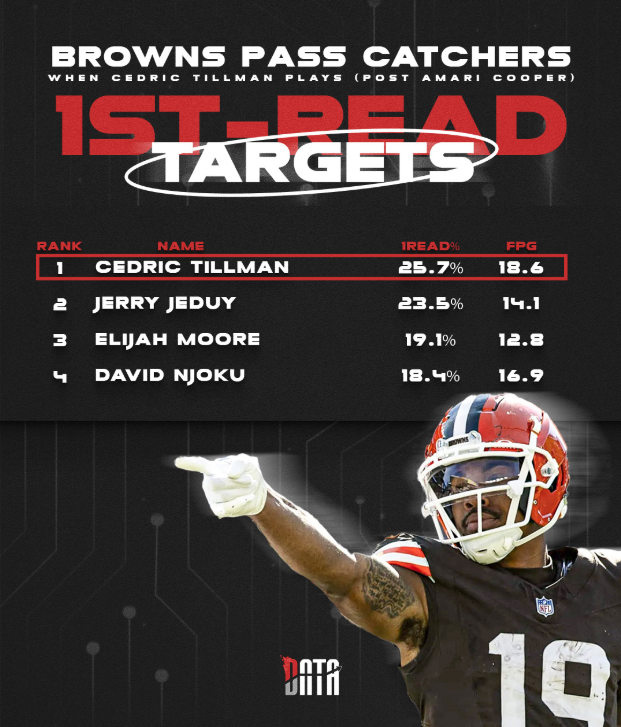
Admittedly, most of this production occurred with Jameis Winston, the most fantasy-friendly QB in the NFL. Tillman won’t have that luxury in 2025, but even after the Browns added little to their receiver group, he’s not being drafted like it. He’s just the WR66 on Underdog and will likely be a free selection in the final round of most managed redraft leagues.
And remember, Tillman (9.8 targets per game) out-targeted both Jerry Jeudy (8.5) and David Njoku (9.3) over this stretch. There’s a real chance he’s the best target earner on the roster, but he goes several rounds after the other two. The Browns will have to find an answer at QB for this to pay off, but the potential reward of getting a team’s WR1 nearly for free is massive.
Dallas Cowboys
As a rookie in 2021, Javonte Williams forced a missed tackle on 27% of his touches (3rd-best among RBs). But since tearing his ACL and LCL in 2022, he’s done so on just 14% and 13% of his touches in back-to-back seasons, ranking bottom-10 in each year.
Williams entered the NFL as one of the most elusive RBs in the league, showcasing elite tackle-breaking ability throughout college as well. But since his multi-ligament injury in 2022, he hasn’t been anywhere close to the same player, respectively ranking 4th-worst, 3rd-worst, and 6th-worst among 44 qualifying RBs in missed tackles forced per touch, yards from scrimmage per touch, and yards after contact per touch. Only Ezekiel Elliott and Kareem Hunt were less efficient over this period.
Per-touch efficiency stats don’t translate directly into fantasy scoring. But in extreme cases where a player has so dramatically declined over multiple seasons, they provide a hint that he’s unlikely to be breaking big plays that will motivate coaches to keep him on the field. On this same team last year, former UDFA Rico Dowdle fully overtook Ezekiel Elliott and his similarly dreadful efficiency by Week 9.
Round 5 rookie Jaydon Blue — who showed off his pass-catching skillset by amassing an impressive 42 receptions at Texas as soon as Bijan Robinson and Jonathon Brooks were out of the way — seems the most likely candidate to eat into Williams’ playing time. He doesn’t necessarily have the size or inside running ability to carry a full-time NFL workload (and never did so in college), but he’s a solid late sleeper in managed leagues.
Denver Broncos
Despite their lead back and primary pass-catching RB in 2024 being the aforementioned washed Javonte Williams, the Broncos led the NFL in target share to the backfield (21.3%).
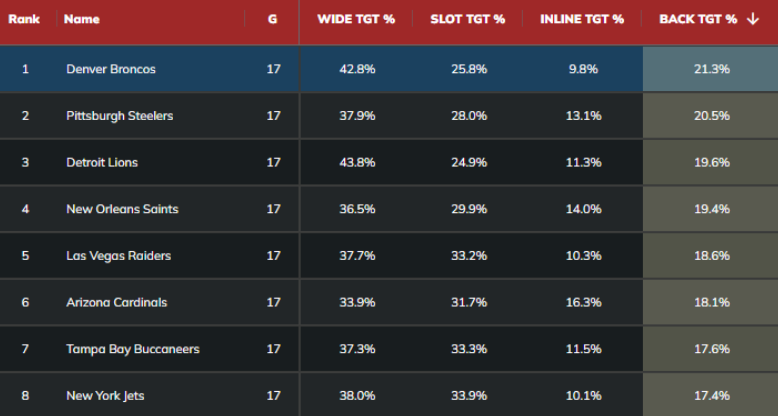
And before that, Sean Payton’s RBs have a long history of leading the NFL in fantasy points. None of the Broncos’ backfield members crushed for fantasy last year due to the workload being split between several sub-par options, but overall usage stats like the one above point to the massive potential fantasy value that remains here.
Explosive pass-catching RBs can be fantasy football gold in Payton’s system. Javonte Williams never fit that mold, but Round 2 rookie R.J. Harvey sure does; he’s athletically similar to Reggie Bush, and was the first RB Payton has selected on Day 2 since Alvin Kamara. Harvey is also an explosive and elusive runner, ranking behind only Ashton Jeanty in Graham Barfield’s Yards Created per carry among the class.
Jeanty would likely need to miss some time or be held back by a mediocre Raiders’ offense for the bet below to hit, but Harvey’s OROY odds are quite appealing to me in a rookie class that lacks many standout QBs to compete for the award. Kamara notably won it back in 2017 over Deshaun Watson.
Recommended Bet: R.J. Harvey to win Offensive Rookie of the Year (+2000)
Detroit Lions
Across four games (including playoffs) with David Montgomery out or limited, Jahmyr Gibbs averaged 165.5 yards from scrimmage per game. If that were extrapolated across a 17-game season, Gibbs would have cleared Chris Johnson’s 2009 record by over 300 scrimmage yards. For further perspective, Montgomery has never reached 165 scrimmage yards in any of his 88 career games.
This isn’t to say I’d ever expect Gibbs to maintain that pace over a full season, with Montgomery healthy or not. But the more actionable way to look at this stat is to consider that Gibbs accomplished this insane feat on an unremarkable 66.4% snap share, which would have ranked just 10th-highest in 2024, near backs like Tony Pollard and D’Andre Swift. This isn’t that far off Gibbs’ 54.4% snap share with Montgomery healthy. He just efficiently amassed all the high-value touches (including 13 of 17 inside the 10-yard line) with Montgomery out or limited.
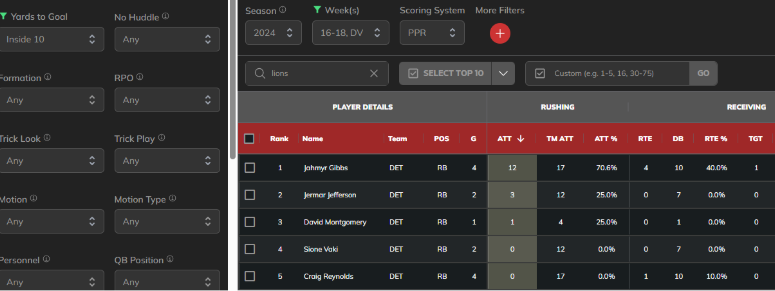
If Dan Campbell and new Lions OC John Morton desire it, there’s a path for Gibbs to play only a handful of additional snaps per game and likely be the most productive RB in the league. This was the NFL’s most valuable fantasy backfield in 2024, even with Gibbs and Montgomery splitting work nearly evenly.
Recommended Bet: Jahmyr Gibbs Over 1075.5 rushing yards
Green Bay Packers
The Packers offense averaged a -4.5% pass rate over expectation (PROE) in 2024, ranking as the 3rd run-heaviest team (adjusted for situation and game script). But over the previous three seasons, HC Matt LaFleur’s offenses ranked 14th-most, 20th-most, and 5th-most pass-heavy.
So what happened? When viewed on a week-by-week basis, we can see that the Packers’ run-heavy game plans coincided with Malik Willis’s starts (Weeks 2 and 3), and then with Jordan Love’s groin injury that he played through from Week 8 on.

Across Love’s five starts before the groin injury, he averaged 22.2 FPG (~QB5) on 35.8 pass attempts per game (~QB4). Across the full season, Love aggressively threw deep 16.5% of the time (2nd-most). With him now fully healthy, the pieces of a productive and high-volume passing attack are in place.
Jayden Reed averaged 18.3 FPG within this same split, while Romeo Doubs led the way with 7.3 targets per game (more than Jauan Jennings and DK Metcalf in 2024). This passing game died in the second half of 2024, but I see a real chance that Reed (ADP: WR44) or rookie Matthew Golden (WR43) help fantasy managers this year.
Houston Texans
As with most QBs, pressure had a large impact on C.J. Stroud last year. Among 32 qualifying QBs, his “highly accurate” throw rate when pressured (28.3%) ranked 6th-worst in 2024. But that jumped to 56.8% on plays Stroud was kept clean (14th-best). And we can observe similar splits across most of his other stats:

Stroud was pressured on 38.0% of his dropbacks in 2024 (behind only Drake Maye), as the Texans’ offensive line was among the worst in the NFL. The Texans responded to this problem by trading away Pro Bowl LT Laremy Tunsil and parting ways with two other 2024 starters, bringing in Cam Robinson and a slew of other free agents to replace them.
Overall, the Texans’ personnel up front isn’t obviously better than last year. Perhaps they’ll perform better against opposing stunts, a test of communication and coaching — former offensive line coach Chris Strausser contemplated retirement before the 2024 season and led a unit that allowed the 2nd-highest pressure rate on stunts in Fantasy Points Data history.
With this in mind, I’m a bit hesitant about both Nico Collins and Joe Mixon at ADP. Defenses had adjusted by the end of the year, limiting them to 14.9 (~WR19) and 15.2 (~RB17) FPG from Weeks 11-17, respectively. I believe Collins is a special player, but the dysfunctionality of the offensive line, paired with one of the best defenses in the league, could continue to encourage conservative play calling from new OC Nick Caley.
Indianapolis Colts
Josh Downs was targeted on 30% of his routes in 2024, ranking 4th-best behind only Puka Nacua, Malik Nabers, and Drake London.
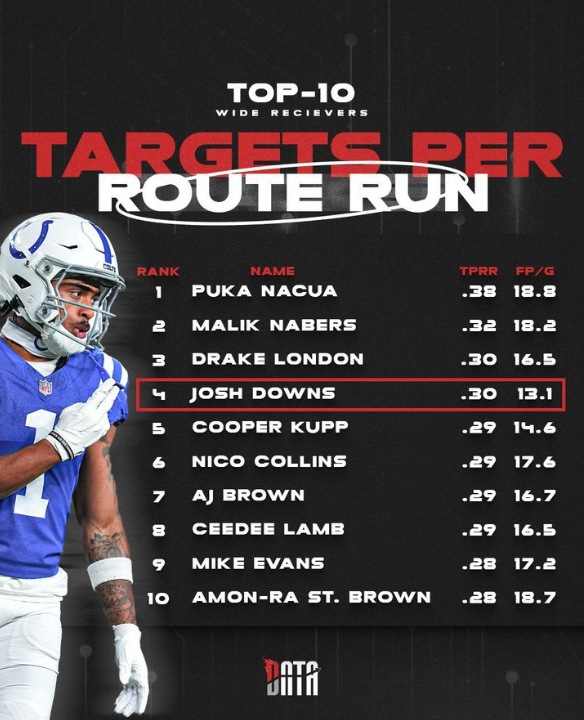
In fact, 8 of the top 10 WRs by targets per route run (TPRR) finished inside the top-13 at the WR position, with Downs and a washed-down-the-stretch Cooper Kupp the only exceptions. The list above consists of many of the NFL’s biggest stars and Downs.
Anthony Richardson may be almost entirely to blame for this. He ranked at the bottom of the league in accuracy while targeting the horizontally breaking routes on which Downs specifically excels, resulting in Downs averaging just 10.7 FPG in Richardson’s appearances.
In contrast, Downs averaged 15.5 FPG (~WR17) in Joe Flacco’s games, and could be similarly productive if Daniel Jones were named the starter (as Michael Pittman and possibly even Shane Steichen himself seem to want). Downs is being criminally underdrafted as the Underdog WR49.
Jacksonville Jaguars
Brian Thomas Jr. played through a chest injury (with which it was initially reported he’d miss up to 4 games) from Weeks 8-11. If we throw those games out, Thomas would have averaged 2.76 yards per route run (YPRR), the most by any rookie in Fantasy Points Data history.
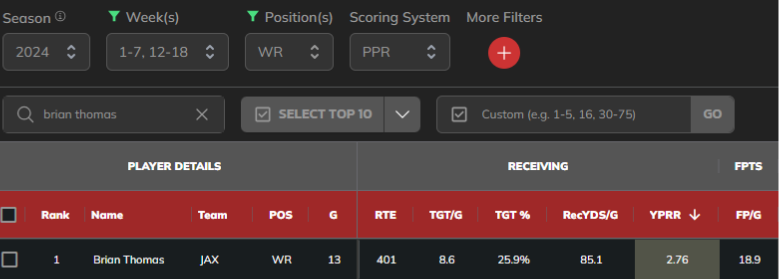
Puka Nacua (2.75), Rashee Rice (2.62), and Ja’Marr Chase (2.58) would rank next after Thomas on that list. In their full games in Year 2, they respectively averaged 104.9, 96.0, and 87.2 receiving YPG, while all exceeded 20.0 FPG.
Across a conservative 15 games, that would come out to a minimum of 1,308 receiving yards for Thomas. We’ve projected an even more conservative number, but still sit comfortably above his 1150.5-yard over/under. Even the addition of Travis Hunter shouldn’t be a major hindrance after the departures of Christian Kirk and Evan Engram.
Recommended Bet: Brian Thomas Jr. Over 1150.5 receiving yards
Kansas City Chiefs
Over the Chiefs’ first three games with Rashee Rice active, over 50% of Xavier Worthy’s routes were vertically breaking. Go routes alone made up 34% of his entire route tree over this period. Both rates would have ranked top-5 among WRs across the full season.
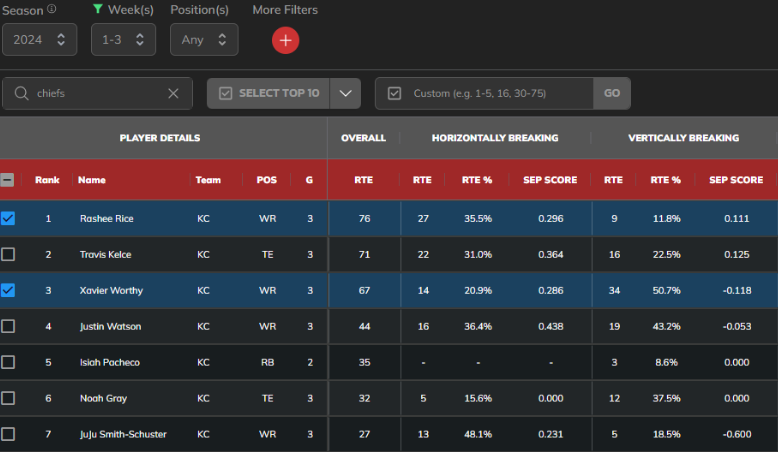
If Worthy reverts to a primarily vertical role with Rice back on the field, that could spell trouble; he earned just a .006 Average Separation Score (77th among 106 qualifiers), 0.53 YPRR (100th), and a 9% TPRR (86th) on those routes over the full year. And those numbers didn’t materially improve down the stretch: from Week 11 on (including playoffs), just 15% of Worthy’s receiving yards came on vertically breaking routes, despite them making up 32% of his route tree.
I’m not very high on Worthy’s ability to develop as a downfield threat, given how disfavorably he compares to other recent busts in these metrics. And I think it’s very likely Rice regains his favorable horizontal routes; they’ve made up 41% of his routes over his first two seasons (would have ranked top-12 at the position last year), and he averaged an absurd and league-leading 5.13 YPRR on them (albeit on a tiny sample) in 2024. The team spent much of the year trying to recreate that between DeAndre Hopkins, Travis Kelce, and JuJu Smith-Schuster to little success.
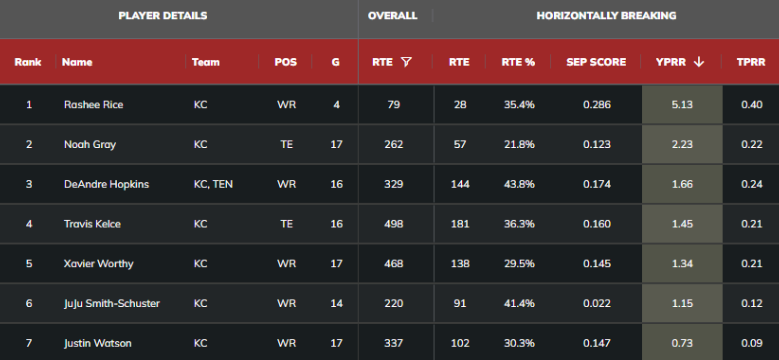
To make a long blurb short, I’m very in on Rice at his WR17 ADP, but not nearly as interested in Worthy as the WR21. Worthy could have a serviceable Year 2 (especially if Travis Kelce continues to decline), but I’d be very surprised at a major breakout driven by downfield shots, given his struggles to separate and Patrick Mahomes’ questionable deep accuracy.
Las Vegas Raiders
Brock Bowers averaged 2.11 yards per route run in 2024, the most by a rookie TE in Fantasy Points Data history. The rest of the Raiders’ receivers averaged just 1.12 YPRR, the 3rd-lowest mark in the NFL.
Yards per route run is a great stat, but it can be influenced by the quality of a team’s QB and overall passing offense. Comparing each players’ YPRR to the rest of their team is one way to account for this.
That Bowers averaged the most FPG (15.5) by a rookie TE since the Vietnam War and set the rookie receptions record (at all positions) despite this environment is extraordinary. There’s an understandable temptation to get incredibly aggressive on him at his Round 2 ADP, but in truth, I’m hesitant about him (and moreso Trey McBride) as such early selections for reasons I lay out here. Though the Raiders’ offense should be much more efficient this year, it’s also highly unlikely a team led by Pete Carroll and Chip Kelly amass the 3rd-most dropbacks in the NFL, as the Raiders did last year. This makes it hard to project Bowers as a top-18 player for fantasy football.
The universe where I’m wrong is the one in which Bowers’ talent is so transcendent that projections can’t appropriately capture his greatness. I’d rather cover that outcome by throwing a unit on a (very) longshot bet than draft him over players like De’Von Achane or Drake London in fantasy football.
Recommended Bet: Brock Bowers to win Offensive Player of the Year (+6000)
Los Angeles Chargers
Ladd McConkey isn’t just a slot receiver; he ranks top-5 in first downs per route run (1D/RR) when lined up outside.
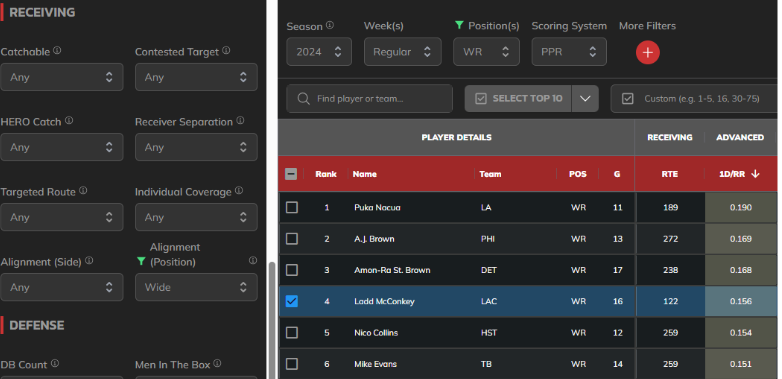
If you have a bias against slot WRs in fantasy football, McConkey is your chance to bury it. He turned his routes from the outside into chain-moving first downs as often as the league’s premier X receivers like Mike Evans and Nico Collins. It’s also instructive that McConkey ranks next to Amon-Ra St. Brown here, the poster boy of the “mostly-slot” archetype that many fantasy managers also foolishly faded after his rookie season.
Like St. Brown, CeeDee Lamb, Chris Godwin, and most other slot receivers that have sustained elite fantasy production, McConkey doesn’t come off the field in 2-receiver sets. His 81.7% route participation rate ranked top-30, above players like Lamb, Godwin, Courtland Sutton, and Terry McLaurin.
Recommended Bet: Ladd McConkey Over 1025.5 receiving yards
Los Angeles Rams
In their games together, Puka Nacua and Cooper Kupp effectively combined for a 67% TPRR. No other Rams player with at least 100 routes across these 11 games was targeted on more than 12% of their routes.
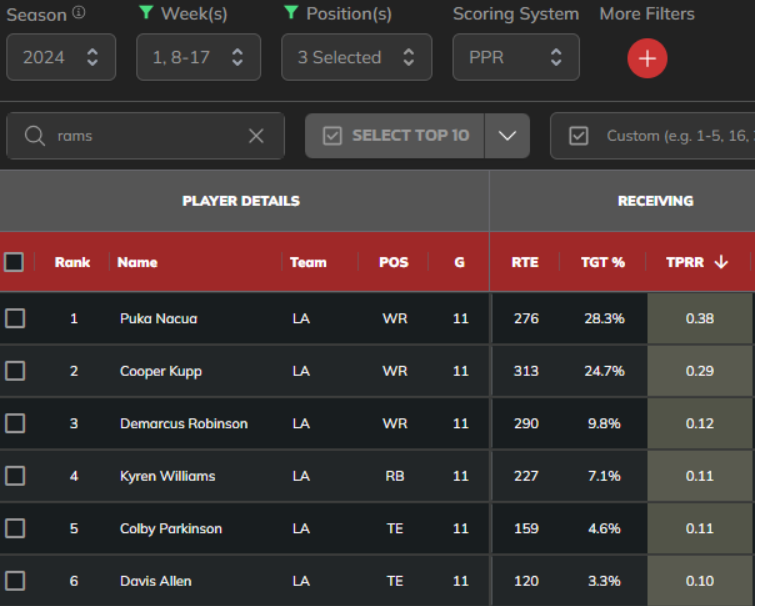
In other words, the Rams ran one of the most concentrated passing attacks we’ve ever seen, with both Nacua and Kupp ranking top-5 in TPRR among all qualifying WRs. If Matthew Stafford dropped back with both Kupp and Nacua on the field, he was throwing to one of them roughly two-thirds of the time.
This was despite Kupp’s separation abilities being visibly diminished at the end of the year. Enter Davante Adams, who just ranked top-5 in first-read target share (35.1%) despite competing with Garrett Wilson, and who did not decline in the same way Kupp did last year, per our separation charters.
Adams is very likely a better overall target-earner than Kupp at this point in their respective careers, and the Rams have literally nobody else to throw to. This feels easy.
Recommended Bet: Davante Adams Over 950.5 receiving yards
Miami Dolphins
Tyreek Hill was worse at separating on vertical routes in 2024 than in 2023. His Average Separation Score (ASS) on these plays was just .069 (33rd), compared to .233 (3rd-best) the year prior.
And the rest of Hill’s per-route metrics (including yards and targets) declined in unison.
This suggests Hill’s decline wasn’t solely a result of the Dolphins’ offensive line leaving HC Mike McDaniel no choice but to pivot to the short passing game. Hill’s inherent ability to gain separation on the deep routes he’d previously feasted on was also clearly diminished. This makes it very plausible we’re simply seeing an early age-related decline for a speed-reliant WR, as Hill turned 31 this offseason.
It’s possible to argue in favor of Hill based on a much-improved schedule (especially schematically). But on the whole, the horrendous and unfocused vibes Hill is giving off this offseason probably outweigh that for me. He’s the sort of player I’ll take a few shots on in Underdog tournaments, but am content largely fading at a top-30 ADP.
Minnesota Vikings
Jordan Addison averaged a higher target share with T.J. Hockenson (19.8%) than without him (16.9%).
In fact, we can do this with several of Addison’s stats. After Hockenson returned, Addison’s receiving YPG (46.2 to 64.4), TPRR (18% to 21%), and most importantly, his FPG (10.0 to 16.3) all noticeably increased.
These splits are probably more a result of Addison’s improved health later in the season after his Week 1 ankle injury than anything magical about Hockenson’s presence on the field, but they still suggest he’s grown into the clear No. 2 target on this Vikings offense that’s ranked top-5 in red zone pass rate during every year of Kevin O’Connell’s tenure.
And 2024 even represented a slight tap of the brakes for one of the best pass-catching environments in the league; while the Vikings still ranked top-3 in intended pass rate measured by PROE (+5.9%), their actual dropback volume (626) ranked just league-average, by far the lowest in O’Connell’s history. If J.J. McCarthy (a top-10 NFL Draft pick and Brett Whitefield’s QB1 in last year’s draft class) is as promised and we see even slight regression from last year’s top-3 defense, this team could well throw even more in 2025. Addison’s WR33 ADP is far too late.
New England Patriots
Across Drake Maye’s 10 full games, Hunter Henry led Patriots receivers in all of the following stats: targets per game (5.9), receiving YPG (44.9), first-read target share (21.1%), catchable targets (50), end zone targets (4), and expected fantasy points per game (10.5). He also ranked as the TE12 by Underdog FPG over this span.

And the last time Henry played under returning OC Josh McDaniels in 2021, he tied for the 6th-most end zone targets among all players (12), scored 9 TDs, and finished as the TE13 by Underdog FPG (8.2). He’s an incredibly attractive late-round value on the platform, going as just the TE22 by ADP with only a Round 3 rookie and a 31-year-old Stefon Diggs coming off an ACL tear as new target competition.
In managed redraft leagues, Henry is an ideal early-season streamer for managers who wish to punt the position, as he’ll play the single-softest TE schedule in the NFL over the first five weeks, drawing the Raiders (who ranked top-3 in schedule-adjusted FPG allowed to TEs in 2024) as a 3.5-point favorite in Week 1.
New Orleans Saints
In 22 career games together with both receivers playing above a 50% snap share, Chris Olave averages 2.06 YPRR. Rashid Shaheed averages nearly the same (2.00 YPRR) in that sample, and he out-scored Olave by 3.3 FPG in their five games together in 2024.
In that smaller 2024 sample, Shaheed’s 14.5 FPG would have ranked as the ~WR21 across the full season. He did this on an impossibly deep 17.7 aDOT, but his production wasn’t just a case of running hot on a few big plays; he also clearly beat out Olave in volume stats like first-read target share (32.2% to 25.3%) and XFP/G (13.6 to 10.3).
Kellen Moore’s offense will be quite different from former OC Klint Kubiak’s deep shot-heavy attack. I won’t pretend to have a strong vision of how Shaheed will fit in, but we have a three-year sample across multiple play callers telling us Shaheed is just as capable a fantasy producer as Olave. For some reason, Shaheed goes nearly four full rounds later on Underdog as just the WR56 by ADP.
New York Giants
Malik Nabers’ 42.8% first-read target share was the highest of any player in Fantasy Points Data history. Higher than Cooper Kupp’s triple crown-winning season in 2021. Higher than Ja’Marr Chase’s when he performed the same feat in 2024. And higher than Davante Adams when his QB and best friend forced a mid-season trade and drove a franchise into the ground so that he could pepper him instead of Garrett Wilson.
And we can be assured this will likely always be the case. The Giants didn’t add any target competition of note, and Nabers will always demand the ball regardless of performance. Locked into the most volume in the league, all Nabers has to worry about is efficiency.
And it will be pretty difficult for any combination of Jameis Winston, Russell Wilson, and Jaxson Dart to be worse than Nabers’ QB play from last year. In 2024, the Giants ranked 4th-worst in catchable air yards per game, yet Nabers averaged 18.2 FPG (~WR7).
Recommended Bet: Malik Nabers Over 1150.5 receiving yards
New York Jets
By most metrics, it was Isaiah Davis, not Braelon Allen, who was the most efficient and explosive Jets rookie RB in 2024.

In fact, Allen ranked dead last among 51 qualifying RBs in explosive play rate (frequency of runs over 15 yards or receptions over 20 yards), behind plodders like Gus Edwards, Kareem Hunt, and a very injured Nick Chubb. Efficiency metrics aren’t particularly predictive for RBs compared to volume, but descriptively, it is still concerning to see a rookie at the extreme low-end with washed veterans.
That’s especially true when Allen’s RB50 Underdog ADP (ahead of seemingly more locked-in handcuffs like Rico Dowdle, Jaylen Wright, and Will Shipley) appears predicated on the idea that he — and specifically not Davis (RB85/undrafted) — can wrestle volume away from Breece Hall. That’s despite HC Aaron Glenn’s original quote, which sent Hall’s ADP plummeting, centering around playing all three RBs, not Allen in particular.
I’m unsure why drafters expect the Jets to maintain loyalty to Allen over Davis because the previous regime drafted him in Round 4 instead of in Round 5. These are similar bets, and we should have relatively low conviction about whether Allen or Davis is a more capable NFL running back. Davis is a great way to get unique in the final round of large-field Underdog tournament drafts.
Philadelphia Eagles
The Eagles posted just a 48% pass rate in 2024. That was the lowest of any offense over the past four seasons, including when the notoriously run-obsessed Arthur Smith’s Falcons were quarterbacked by Marcus Mariota in 2022.
That explains pretty well why A.J. Brown’s 16.7 FPG was his lowest since he played for Arthur Smith back in 2021. But whenever the Eagles threw, Brown was still electric, ranking 2nd-best among 91 qualifying WRs in YPRR (3.22) and FP/RR (0.55). All he’ll need for a big bounce-back in 2025 is some additional pass volume.
And that seems more likely to happen than not. On average, teams as run-heavy as the Eagles see a 20% increase in pass attempts per game the following season. That’s because maintaining such a run-heavy approach requires both an elite defense and control of the game script week in and week out; advantages that are inherently hard to maintain for long. For example, the Eagles’ pass rate ballooned to 58.2% while trailing last season, and their opponents in 2025 combine to rank top-5 in Vegas win total. A tougher real-life schedule means more pass volume and more production for Brown (and Devonta Smith).
Just for fun, with that average 20% increase in pass volume while holding his 2024 efficiency constant, Brown would have amassed 1,294 receiving yards over just 13 games, or 17.0 Underdog FPG (~WR2). That leaves a lot of room for him to smash his mid-Round 2 ADP.
Pittsburgh Steelers
After dealing with hamstring and knee injuries early in the season, Jaylen Warren narrowly out-snapped Najee Harris 275 (47.7%) to 257 (44.6%) across the Steelers’ final nine games post-bye.
The team let Harris go in free agency, electing to draft big-bodied Iowa RB Kaleb Johnson out of Iowa in Round 3. My base expectation is for Johnson to more or less slide into Harris’s old role (predominantly on early downs), with Warren’s playing time in passing situations safe as Johnson works on his pass protection skills.
This would be a fantasy upside-limiting arrangement for both backs, especially considering that presumed 2025 Steelers QB Aaron Rodgers ensured the Jets led the NFL in pass rate inside the 10-yard line last year. The Jets’ 75.4% green zone pass rate was a full 12% above the next-closest team (63.3%).
Rodgers likely won’t have as much control under Mike Tomlin and Arthur Smith as he did with the Jets. But still, the possibility of somewhat fewer goal-line opportunities in an offense projected to average the 7th-fewest points per game by Vegas lookahead lines has me pretty uninterested at Johnson’s RB25 Underdog ADP.
San Francisco 49ers
The 49ers’ top receivers in 2025 are likely to be Jauan Jennings, Ricky Pearsall, and George Kittle. In those players’ seven healthy games together last year, Kittle averaged 82.3 receiving YPG, which would have led all TEs over the past four seasons.
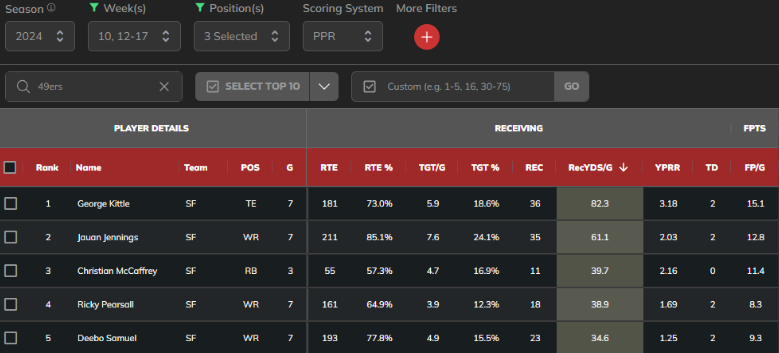
This sample included Deebo Samuel, who was traded to the Washington Commanders this offseason. In six games without Samuel, Kittle has averaged 19.6 FPG since 2022. In nine different games without Brandon Aiyuk (who’s likely to start the season on PUP), Kittle averaged 16.3 FPG.
Admittedly, Kittle will turn 32 years old during the season — which can be the start of the decline for elite producers at the TE position — but he’s shown no signs of slowing down. He leads all TEs in YPRR over the past four seasons (by a lot) yet still has some age-related decline priced in to his ADP. He goes outside the first four rounds on platforms like Underdog, behind WRs we project him to out-score straight up like Xavier Worthy and Jameson Williams. This one is pretty simple.
Seattle Seahawks
During Klint Kubiak’s two seasons as an OC, his backfields have ranked 10th and 1st in total targets. And Alvin Kamara averaged 1.8 screen targets per game under him in 2024, ranking behind only De’Von Achane.
Kenneth Walker is a logical candidate for this usage in 2025 after posting a career-best 12.7% targets share (~RB5), with the team committed to using him on all three downs. In the run game, Walker also fits Kubiak’s outside zone scheme (according to both the data and the man himself).
Walker remains grossly underpriced as the Underdog RB19 after ranking 8th-best at the position in weighted opportunities per game (16.2) and 15th-best in Underdog FPG (14.4).
Tampa Bay Buccaneers
Bucky Irving only ran more routes than Rachaad White in three of their 16 games together. In them, he averaged 22.2 FPG (~RB2).
I wouldn’t expect Irving to dominate passing down snaps in 2025, as the team has consistently stated they want White to remain involved. But OC Josh Grizzard has also described his plans for the backfield rotation (per the CoachSpeak Index Discord) by saying “how we ended last season was essentially where we would take off.” All three of the aforementioned games came at the end of last season, with Irving averaging 17.9 XFP/G (~RB6) across his five healthy post-bye games.
The party line in Tampa Bay has long been that they want all three of their RBs involved, but if “involved” in their minds mean Irving’s post-bye usage (dominating carries with receiving work split near-evenly), Irving will smash his RB9 ADP.
Tennessee Titans
Tony Pollard has ranked top-5 among RBs in yards after contact per attempt during three of the past four seasons.
The only time he didn’t was in 2023, coming off tightrope surgery and averaging a career-low 4.0 YPC. But he bounced back in 2024 in this somewhat blocking-agnostic efficiency metric.
HC Brian Callahan is suggesting Pollard will split work with Tyjae Spears for a second consecutive offseason. Despite similar comments last year, Pollard commanded 59.0% of the Titans’ rush attempts (~RB10) in his healthy games alongside Spears.
Washington Commanders
From 2021-2022, Kliff Kingsbury’s offenses averaged 8.1 pass attempts per game at or behind the line of scrimmage (most in the NFL, or the same as the Miami Dolphins in 2024).
That fell to just 6.0 in 2024, or even further to 3.9 without Dyami Brown and Olamide Zaccheaus, neither of whom are on the Commanders in 2025.
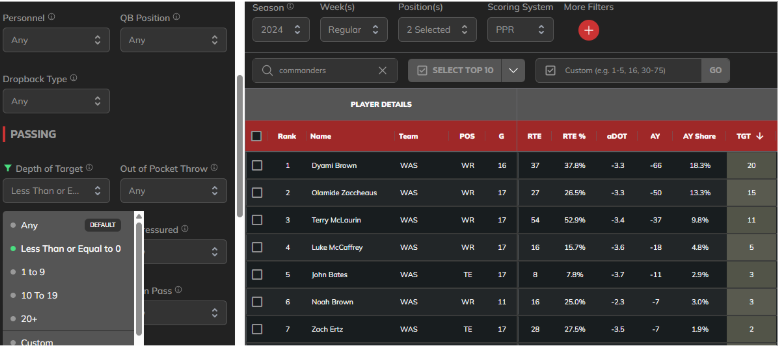
In other words, there could be up to 4.1 targets per game behind the line of scrimmage in this offense instantly earmarked for new arrival Deebo Samuel. Over the past two seasons, Samuel averages just over 2.0 fantasy points per target on these looks (4th-best). He’s the perfect piece for Kingsbury’s “horizontal raid”, leading all WRs in yards after the catch per reception (min. 50 catches) during each of the past four seasons.
Samuel goes off the board as the WR38 on platforms like Underdog. I’d give him at worst a 40% chance to outscore Terry McLaurin (WR15).




